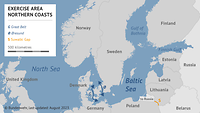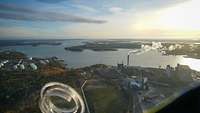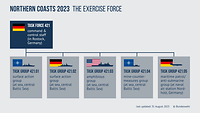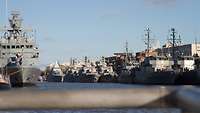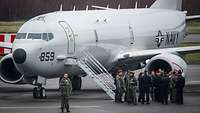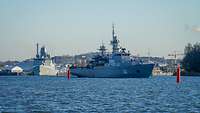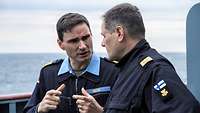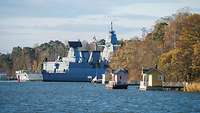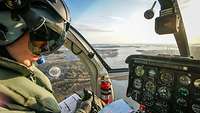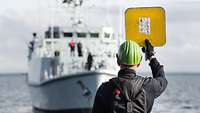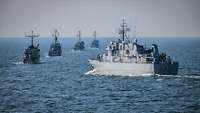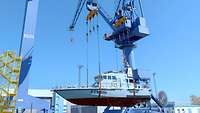Northern Coasts: Germany‘s invite to Baltic Sea exercices
Since 2007, the German Navy has been organising annual naval exercises with its partners on NATONorth Atlantic Treaty Organization‘s northern flank. This maritime collective defence is particularly important for Lithuania, Latvia, Estonia and Finland.
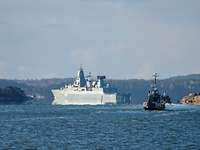
Why is Northern Coasts taking place?
Northern Coasts is a multinational invitation exercise for NATONorth Atlantic Treaty Organization allies and EU countries. The large-scale exercise was launched by Germany in 2007 and takes place annually in the Baltic Sea. The main intention of Northern Coasts is that the participants train in naval warfare – embedded in a realistic overall scenario within a coastal environment under several assumed threats.
While in the first years of the exercise series piracy and terrorism were the main focus, today the emphasis is on national and alliance defence, especially on NATONorth Atlantic Treaty Organization’s north-eastern flank. Northern Coasts thus strengthens the individual participants in being able to react coherently, appropriately and consistently, especially to symmetrical military threats from the air, from above and below the sea, as well as from land.
These threats are constantly evolving: missiles, for example, are reaching ever higher speeds, drones are making their way into naval warfare above and under water. NATONorth Atlantic Treaty Organization allies and partners therefore sometimes use exercises like Northern Coasts to jointly develop tactics and procedures as well as to put new technical systems to the test.
Who is responsible for Northern Coasts?
The Baltic Sea neighbours Germany, Denmark, Sweden or Finland are responsible for planning the large-scale exercise. They take turns on a regular basis after consultation.
Central responsibility, as for every naval exercise, is assumed by the respective flag officer who orders the exercise, in NATONorth Atlantic Treaty Organization English this is the Officer Scheduling the Exercise (OSE). For Northern Coasts, this is the German Chief of Navy. Meanwhile, planning and execution are the responsibility of the so-called Officer Conducting the Exercise (OCE), usually another admiral.
The OCE either already has his own staff or he is assigned a team for the exercise. This staff is responsible for the detailed planning, which usually begins several months before the respective exercise.
Where does the large-scale exercise take place?
Northern Coasts takes place every year in the Baltic Sea. Each time, the participants use different sea areas. How these areas are defined depends mainly on which country is acting as host nation.
In 2019, for example, with Denmark and Germany as joint hosts, the exercise area were the Baltic Sea Approaches to the west of the maritime region. In 2023, Latvia and Estonia are host nations, so Northern Coasts will take place in the central Baltic Sea off the coast of the Baltic States.
What are the overarching goals of the naval exercise series?
All Baltic Sea countries that are also members of NATONorth Atlantic Treaty Organization or the EU have a common interest in security in the greater region. In order to protect trade routes and military supplies across the Baltic Sea or to counteract scenarios of being cut off from them, the participants in Northern Coasts aim to strengthen cooperation, especially between their naval forces.
Like every military exercise, Northern Coasts has two essential goals, only specifically related to the Baltic Sea region, including above all the Baltic States and Finland: on the one hand, to train and further develop the participating naval personnel with their weapon systems, and on the other hand, to demonstrate military capabilities and political unity. Thus, the NATONorth Atlantic Treaty Organization members on the Baltic Sea and their partners show the will to defend the region, foremost Finland and the Baltic states.
Which nations participate in Northern Coasts?
NATONorth Atlantic Treaty Organization and EU nations that are also Baltic Sea states or have a special interest in the region and the defence of the Alliance’s entire northern flank regularly take part in Northern Coasts. In addition to Germany, Denmark, Sweden and Finland, which are alternately responsible for planning, Lithuania, Latvia, Estonia and Poland also regularly participate. In addition, there are countries such as France, Great Britain, Norway and the USA involved.
As a rule, NATONorth Atlantic Treaty Organization partners provide most of the participants. But even as EU members, both Finland and Sweden have already been integrated into the large-scale exercise.
What is the difference to the better-known large-scale manoeuvre BALTOPSBaltic Operations?
BALTOPSBaltic Operations, or Baltic Operations in its long form, is an USUnited States-led large-scale naval exercise that has existed since 1972. It thus has its origins in the Cold War. The Northern Coasts series of exercises, launched by the German Navy, has only existed since 2007 and is based rather on the desire for closer cooperation between all NATONorth Atlantic Treaty Organization and EU partners in the Baltic Sea region in the post-Cold War era. Main reason for this was NATONorth Atlantic Treaty Organization’s enlargement in 2004 to include the Baltic states: Estonia, Latvia and Lithuania.
The first Northern Coasts scenarios were more oriented towards crisis management and conflict prevention, including the fight against terrorism. Since 2014, however, the focus has increasingly turned to national and collective defence. In this way, however, Northern Coasts now also has common ground with BALTOPSBaltic Operations. Both are ideal opportunities to train together for all partners, especially of course for the countries of the Baltic Sea region.
What is the importance of the Baltic Sea for Germany and other countries bordering it?
The Baltic Sea is a maritime lifeline, with more than 2,500 ships carrying export and import goods every day. In everyday life at sea, ferry traffic and fishing activity are also important. This makes this marginal sea of the Atlantic Ocean one of the sea areas with the highest maritime traffic density in the world. Not only Poland, Finland and the Baltic states depend on these sea routes, but also Germany in a special way. After all, Germany is one of the top five trading partners of all Baltic Sea countries; for Denmark, Finland, Poland and Sweden it is even the most important.
Blockades or armed conflicts in the Baltic Sea may have the effect of interrupting these trade flows between the riparians. The delivery of even everyday products and resources such as supermarket items or fuel would then affected.
The same applies from a military point of view. For the most important supply routes for NATONorth Atlantic Treaty Organization to Finland and the Baltic States – and thus to the Enhanced Forward Presence troops stationed there – run over sea. There is a land connection between Poland and Lithuania, but the corridor between Russia’s Kaliningrad and Belarus is only 65 kilometres wide. A railway line and two motorways run through this so-called Suwalki Gap, which can only handle a small transport volume compared to sea routes. They may also be quickly interrupted in case of conflict.
A third, but again civilian, aspect is the maritime critical infrastructure in the Baltic Sea. As in the North Sea, there are wind farms, data and power cables as well as natural gas pipelines here. These facilities are gaining in importance, or rather are increasing in number, especially because the Baltic states are linking up with Scandinavia’s power grids.
How challenging is the Baltic Sea sea area for the participating navies?
The Baltic Sea is a so-called marginal sea, characterised by rather shallow waters and little manoeuvring space for particularly large ships. The shallow water depth limits submarines in operating effectively and also makes the sea region an ideal operational area for naval mine warfare.
In addition, every point on the open Baltic Sea is not far from land and thus always within range of aircraft or guided missiles. Partly indented coastlines reinforce this, because a potential attacker may well hide behind every headland. This means that warning times are extremely short in the event of a conflict. For civilian ships, but also for warships, navigating the Baltic Sea during a conflict would therefore be associated with great risk.
Added to this are the bottlenecks in the Baltic Sea access routes. These are the waterways between Denmark and Sweden respectively between the Danish islands: the Øresund, the Little Belt and the Great Belt. The latter is the main maritime transport route and is only a good ten kilometres wide at its narrowest point. The one alternative is the Kiel Canal. All these narrows are easy to control, but may also be closed quickly – for example by sabotage or naval mines.
What impact does Northern Coasts have on everyday civilian life?
Despite dozens of participating warships in a relatively large sea area, the exercise generally has little impact on civilian shipping. The respective exercise area lies away from established trade routes, for example not directly at the Baltic Sea accesses Øresund, Little Belt, Great Belt or Kiel Canal. It avoids wind farms as well as the most important fishing areas, and also avoids the territorial waters and exclusive economic zones of non-participating countries.
The German Navy and the respective host nation for Northern Coasts also officially announce the exercise several weeks before it begins via the international “Notices to mariners”. The published information contains the duration of the exercise and the geographical coordinates that delimit the exercise area. Comparable information applies to the airspace above the exercise. Thus, civilian shipping and air traffic are always forewarned and informed.
In addition, civilian shipping is even involved in Northern Coasts on a voluntary basis. Some merchant ships currently underway in the Baltic Sea, for example, offer to be available for boarding exercises. In this way, marines and naval infantry train to inspect foreign ships. The prerequisite is, of course, that no major delays occur in the schedule of the merchant ship. For such occasions, among others, the naval forces cooperate closely with the respective shipping companies through the NATONorth Atlantic Treaty Organization-wide system Naval Coordination and Guidance for Shipping.
How are the participating warships organised?
The participating naval vessels consist of warships with different capability profiles. In Northern Coasts, as in basically every major naval exercise, naval vessels specialising in air and surface defence, anti-submarine warfare and mine countermeasures participate. In addition, some nations send air and land forces, sometimes including naval infantry.
During the exercise, the warships organise themselves as task groups, sub-units composed according to specific capabilities – usually for surface and underwater combat on the one hand, and mine-countermeasures on the other. If permanent NATONorth Atlantic Treaty Organization naval forces take part in Northern Coasts, they usually do so in unison. In principle, these are Standing NATONorth Atlantic Treaty Organization Maritime Group 1 and Standing NATONorth Atlantic Treaty Organization Mine Countermeasures Group 1, because the Baltic Sea falls within their area of responsibility anyway.
Each task group is headed by its own commander, the Commander Task Group (CTG), on board a dedicated flagship. They are all subordinate to a superior Commander Task Force (CTFCommander Task Force), who leads the naval formations with his staff from ashore. During the exercise, this CTFCommander Task Force assumes two roles: on the one hand, they themselves trains the real-life emergency of leading naval formations with dozens of warships; on the other hand, they are the supreme arbiter of the exercise to evaluate the behaviour of their subordinate CTGs and military units.
Because each iteration of Northern Coasts involves partly different warships with different capabilities, each individual exercise means that CTGs and CTFs have to take these specialisations into account. This includes, above all, the technical capabilities of the different sensors and weapon systems. Air surveillance radars from individual frigates, for example, can differ significantly in range alone. In the same way, the ranges of torpedoes are sometimes very different.
How does Northern Coasts prepare naval forces for military conflict?
Like all naval exercises lasting several weeks, Northern Coasts is divided into two main phases. In the first part of the large-scale exercise, the individual vessels respectively their crews are to join together in the teams of their respective task groups. This preparatory phase is called CET/FIT.
During Combat Enhancement Training (CET), the ships and crews train individually or in pairs. Force Integration Training (FIT) switches the focus to ensuring that the entire task group works together smoothly. This is to ensure that the crews master increasingly advanced individual exercises, called serials, and that the naval vessels from different nations continue to refine their coordination. While the individual vessels improve in shooting at sea targets or towing each other during CET, the task groups practise driving in large formations or improve their communication with each other during FIT.
Once the preparatory CET/FIT phase is over, the so-called Operations Phase, or OPS Phase for short, also known as Free Play, begins. This exercise phase puts all participants, embedded in a fictitious scenario, to the test for several days.
For this purpose, the CTFCommander Task Force and his staff on shore have to lead their own actions on the one hand and keep an eye on the overall situation on the other. All formation commanders, the CTFCommander Task Force and the subordinate CTGs, must divide the emerging tasks sensibly and skill-based among the vessels within the task groups. All those involved must be able to respond to unexpected events and sudden incidents 24/7.
As a rule, one of the several task groups takes on the role of the opposing force during the OPS phase. This ensures that both sides – blue and red – have to deal with a realistically behaving opponent. In general, all the individual exercises of the large-scale exercise are designed to be as realistic as possible. Among other things, this means that the OPS phase runs around the clock for several days.
What does it mean to improve interoperability between armed forces?
Like all military exercises, Northern Coasts is intended to promote so-called interoperability between all participating naval, ground and air forces. What is meant by this is the ability to cooperate between the various national armed forces of an alliance, some of which have different equipment – primarily on the basis of common standards and procedures. A German frigate, for example, differs in many details and specific capabilities from a Polish or a Danish one.
Interoperability works on three levels: common language, procedures and tactics, common command structures, as well as compatible equipment and logistics. This includes, for example, that NATONorth Atlantic Treaty Organization troops communicate with each other in English as a matter of principle, using the same military terminology. In combat, they act according to the same rules with equipment that is as comparable as possible. Headquarters and staffs are organised in the same way so that staff personnel can perform comparably and communication between those in charge functions as smoothly as possible. For example, the larger navies of the Alliance have command staffs that are all organised according to NATONorth Atlantic Treaty Organization standards as a so-called Maritime Component Commands.
Impressions: This is Northern Coasts
published on: 25/08/2022, last updated: 25/08/2023
location: Rostock
reading time: 9 minutes


